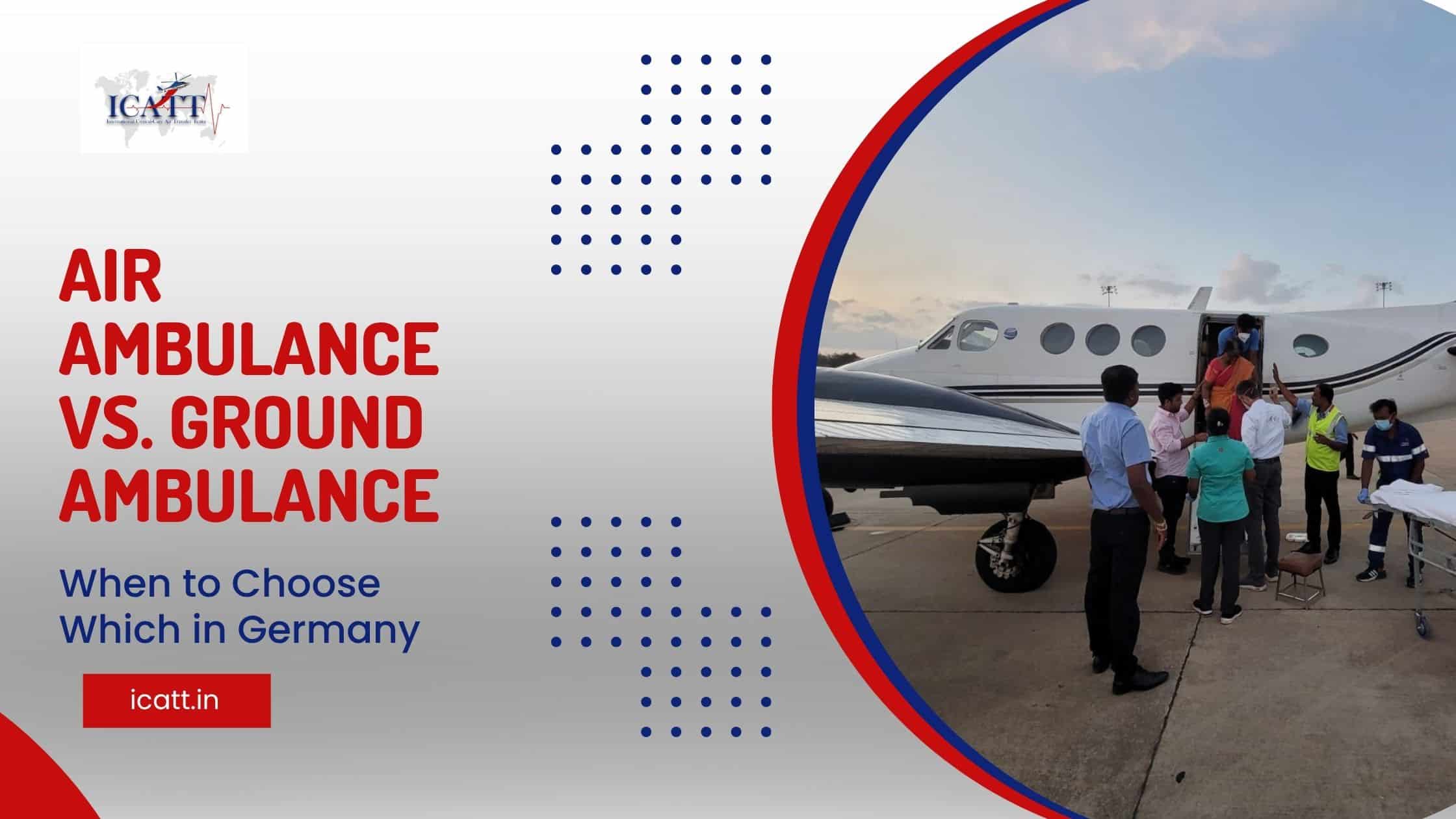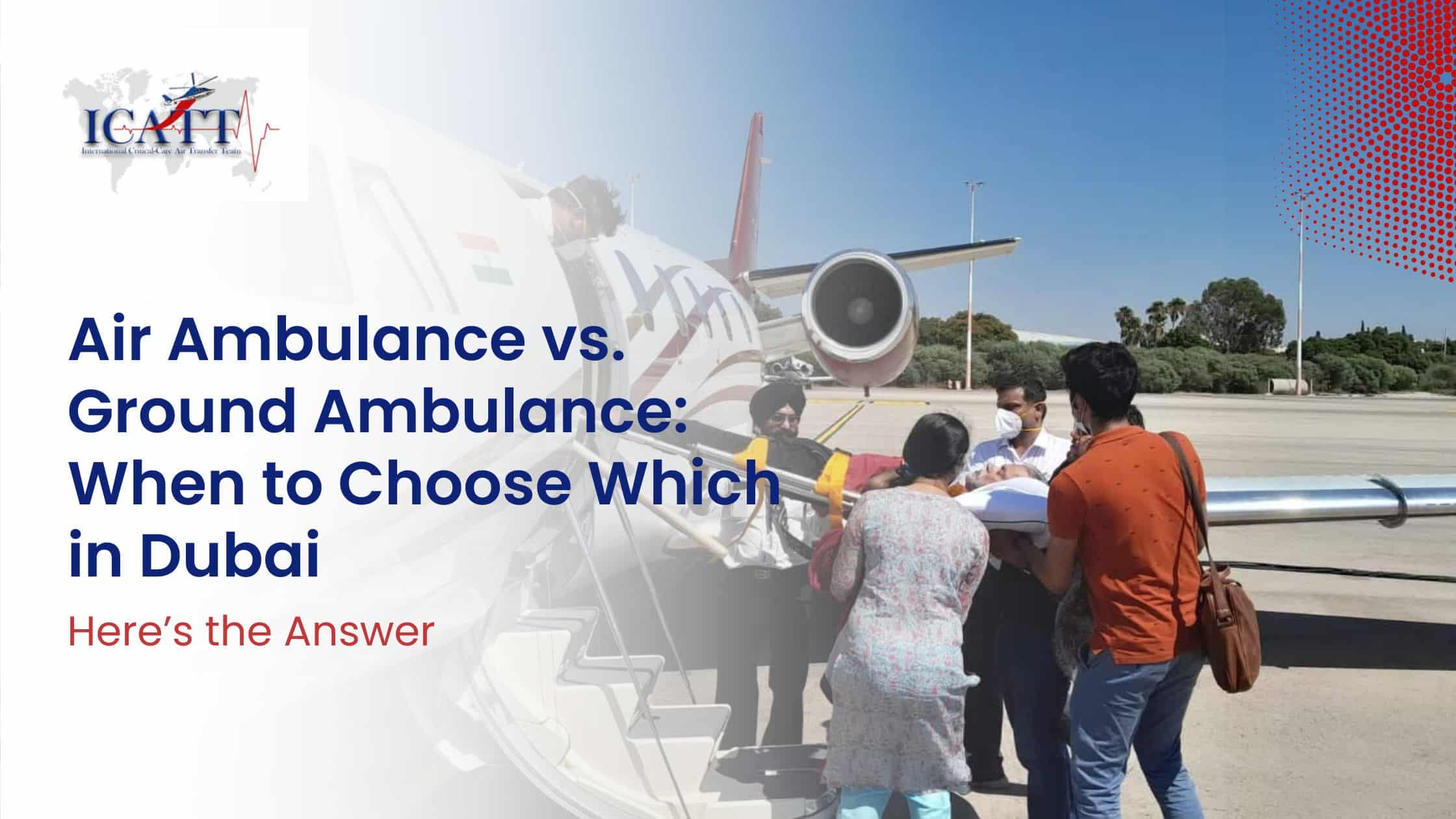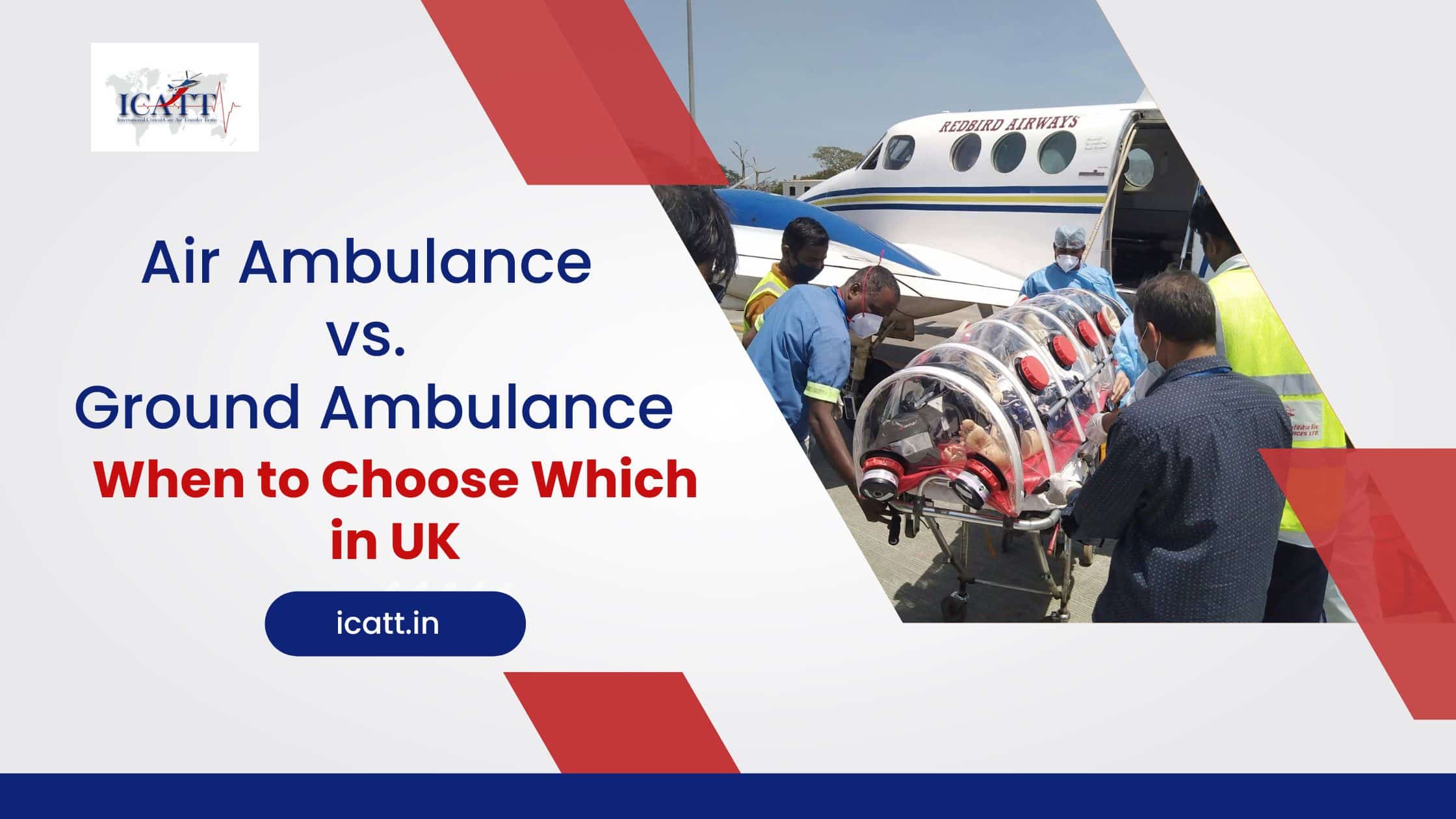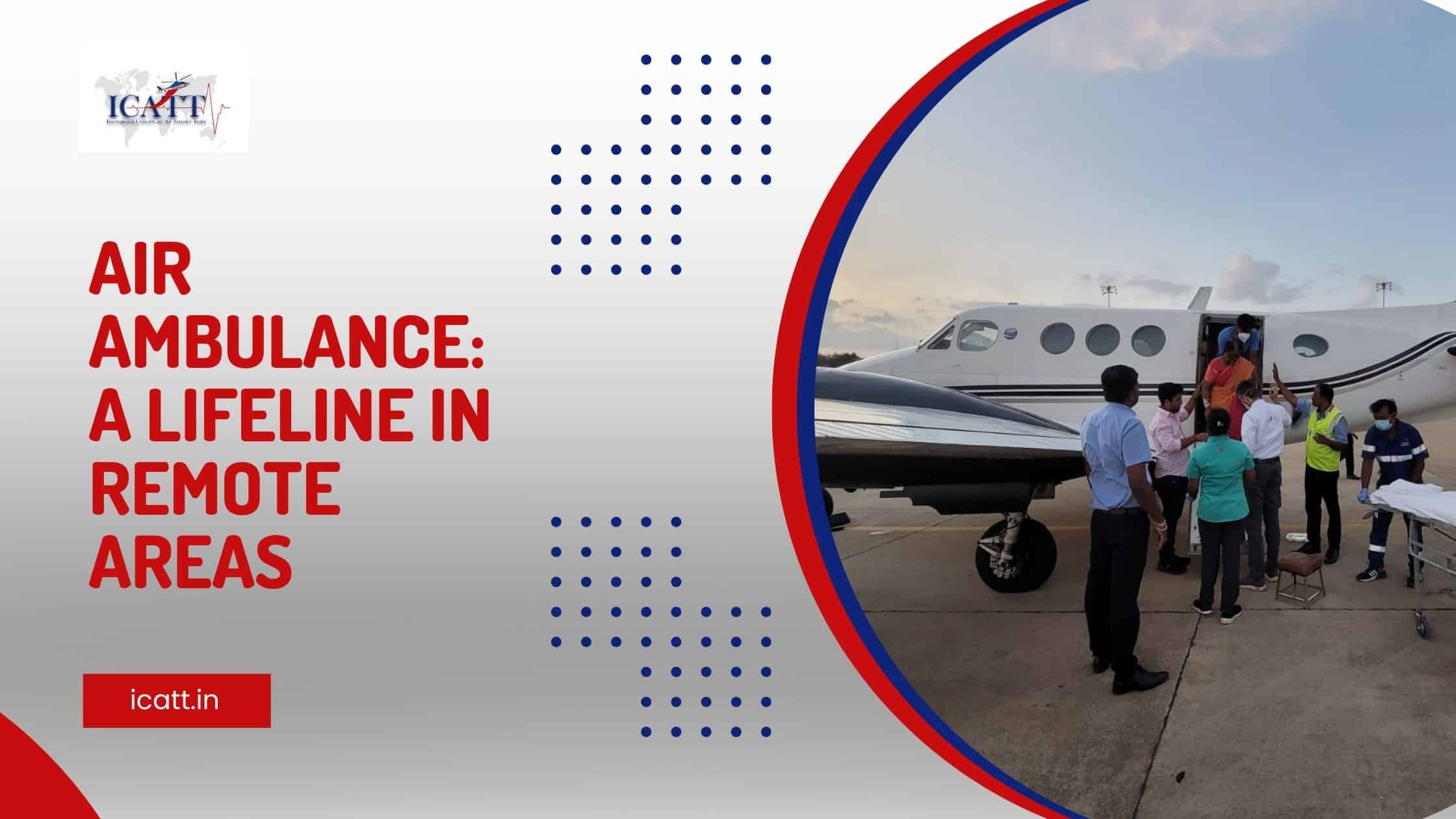In any emergency situation, the mode of medical transport is important and can make all the difference. So, when we talk about Canada, what usually comes in our mind is its huge landscapes and perhaps difficult geography. During emergencies, patients and their families often ask one question whether they should take help from a ground ambulance or request quick intervention of an air ambulance.
In this blog we will review all the important points of difference between air ambulance and ground ambulance services in Canada along with the circumstances in which each is most effective. Also, you will have an in-depth awareness of how both services fit into the country’s healthcare system and when to choose air ambulance in Canada.
Understanding Medical Transport in Canada
Before we get into the details, it’s important that we first understand Canada’s unique healthcare conditions.
- The reality of emergency transport in Canada varies greatly depending on where emergency transport is required: whether in bustling urban metropolitan cities or isolated villages, islands, and Northern communities.
- In nearly all urban/ metropolitan emergencies, the first choice is ground ambulances because of their accessibility, paramedics, and basic emergency supplies.
- On the other hand, air ambulances services in Canada are most important when no roads exist, or distances are too long to cover.
So, we are not only talking about medical transport, but also how healthcare transforms according to geography, accessibility, and urgency.
Ground Ambulance: The Everyday Lifeline
We are all most familiar with ground ambulances because they have been around the longest and are the ones we hear about most often.
It makes sense because these are the usual emergency responder vehicles that we see speeding by on highways and around metropolitan city streets every day. Ground ambulances can successfully and quickly stabilize patients with the help of paramedic training and lifesaving equipment such as oxygen, a defibrillator, or a trauma kit, and transport them to the nearest hospital.
Advantages of Ground Ambulance in Canada:
Here’s why ground ambulances remain such an important part of the healthcare system:
- Accessibility: Almost every town and city in Canada has ground ambulances. There are majority times a ground ambulance service nearby, whether you live in a small residential community or in a large area like Toronto or Vancouver.
- More affordable option: The typical ground ambulances are mostly far less expensive than air ambulances. So, for emergencies where a patient is not required to travel long distances, this makes it the first and most sensible option.
- Quick within city limits: Dispatch times are extremely quick in populated locations. It is a reliable source in urgent circumstances, as paramedics can arrive on the scene within minutes of the call for service.
- Best for short distances: Ground ambulances are fine to go for if the closest hospital is within 30 to 60 minutes’ reach. They are designed to keep patients stable while guaranteeing a smooth and secure transfer.
Limitations of Ground Ambulance in Canada
Although ground ambulances are one of the most reliable modes of transport, but have limitations that could negatively affect patient outcomes and response times:
- Traffic delays: In large cities like Toronto, Vancouver, or Montreal the traffic is a huge problem because of which ambulances can’t arrive on time.
- Winter road conditions: Typically, during Canada’s harsh winter months there are ice roads, snowstorms, and in some areas the complete road closures. So, even these conditions cause delays for ambulances in some instances, restricting access to some communities temporarily.
- Accessibility in Remote and Northern Regions: Many of Canada’s large rural as well as remote areas lack adequate road networks. This makes it impossible to guarantee that people can rely on ground ambulances at all in these situations.
Therefore, in urban and suburban areas, ground ambulances are a safe and economically priced option for the majority of situations. They work well in areas where roads are clear, and hospitals are somewhat within reach. But in remote, northern, or difficult-to-reach locations, ground ambulances are not always the fastest method; instead, air ambulances play an important role.
Air Ambulance Canada: Flying ICUs
In Canada, when ground ambulances are inadequate, an air ambulance act as the safety net that helps to reach on time, covers long distance in minutes, and ensure the patients survival is handled properly. In simple words, they are flying ICU’s – equipped with ventilators, advanced cardiac monitors, defibrillators, oxygen tanks, lifesaving medications and in some cases physicians who have specialization. These are not just planes with a stretcher; they are a lifesaving transport that have saved thousands of lives.
The goal is simple: to provide essential hospital -level care while moving patients quickly and safely, particularly when every second counts.
Advantages of Air Ambulance in Canada
Here’s why choosing an air ambulance can be lifesaving in certain situations:
- Covers Long Distances in Minutes
Did you know that Canada is among the largest countries in the world, based on land area? An air ambulance can transfer patients quickly, which means within one to two hours, whereas it could take eight to ten hours by road. Also, for patients who are being transferred for organ transplants, severe trauma, stroke, or cardiac arrest, this speed of transport makes all the difference.
- Reaches Remote and Northern Regions
Road ambulances cannot easily access the Canada’s rural villages, island locations, and northern territories. By overcoming this barrier, air ambulances ensure that the treatment and chances of survival are the same for patients living in remote environments as those in urban areas.
- Advanced Onboard Critical Care
Air ambulances have experienced & highly skilled medical staff, usually paramedics, nurses, and at times doctors on duty who manage crises while in flight. Patients receive intensive care unit (ICU) facilities and monitoring during the transport.
- No Traffic or Road Barriers
Air ambulances fly above and beyond the obstacles like Toronto’s heavy road traffic or snowstorms delay that most ground ambulances get caught in. Air ambulances take the most direct route possible to ensure the fastest and safest transfer.
Difference Between Air and Ground Ambulance Services in Canada
To make this easy to understand, here’s a simple breakdown:
| Factor | Ground Ambulance | Air Ambulance Canada |
| Distance Covered | Works best for short to medium distances (up to 30–60 minutes from a hospital). | Ideal for long distances, it can cover hundreds of kilometers in just a couple of hours. |
| Availability | Common and accessible in most cities, towns, and suburban areas. | Not limited to region-specific cases; usually coordinated for remote, rural, or critical cases. |
| Speed | It can be delayed by traffic, road conditions, or weather. | Much faster, as it flies over obstacles like traffic jams and snow-blocked highways. |
| Medical Suitability | Best for non-critical cases or when hospitals are relatively close by. | Tailored for critical, time-sensitive, or remote emergencies, with advanced onboard care. |
| Onboard Facilities | Equipped with basic to moderate emergency tools (oxygen, defibrillator, and trauma kits). | Functions like a flying ICU with ventilators, advanced cardiac monitors, oxygen supply, and critical medicines. |
| Accessibility in Remote Areas | Limited access, as cannot reach areas without road networks. | It can land in remote or isolated regions, including northern territories and islands. |
When to Choose Air Ambulance in Canada
This is the most important query that families face. When to choose air ambulance in Canada over ground transport?
Here are the key scenarios:
Remote or Northern Communities
If you live in Yukon, Nunavut, or rural Quebec, you must be aware that the nearest tertiary hospital is hundreds of kilometers away. This makes ground travel in an emergency not at all possible. So, the only lifeline in isolated places is an air ambulance.
Critical Time-Sensitive Emergencies
Quick action is very important during brain injuries, heart attacks, and strokes.
An air ambulance is a better option if travelling by car would cause you to miss the “golden hour.”
Disaster or Accident Zones
Air ambulances are highly helpful in situations where ground access is limited or restricted, such as industrial accidents, forest fires, or highway pile-ups. The best example of this would be the LA forest fires when air ambulances were rescuing people from hilly areas where fire was spreading quickly, or in India when natural calamity takes place in mountain areas, air ambulances are the first point of rescue.
Inter-Hospital Transfers
When a patient is transferred from a small hospital to a specialist facility, air ambulances guarantee continuity of care during transit.
Hence, the answer to the question “When to choose an air ambulance in Canada” frequently comes down to two factors: urgency and distance.
Real-Life Example: Urban vs. Remote
To make it relatable, imagine two situations:
- Case 1: Downtown Toronto
A patient collapses from a suspected stroke. Within minutes, a ground ambulance arrives, and since the nearest stroke-ready hospital is only 15 minutes away, road transport works best.
- Case 2: Northern Manitoba
A logging worker suffers a severe head injury deep in the forest. No direct roads, no quick ground routes. Here, an air ambulance Canada service is dispatched, reaching him in 40 minutes and transporting him to Winnipeg for neurosurgery.
Both stories show why emergency transport in Canada needs both options.
Therefore, when time and distance become life-threatening obstacles an air ambulance is as important as ground ambulances because they bridge an essential gap to save life. It brings experts on board with all the ICU level equipment readily available in aircraft, and they ensure that not only the most remote patients, but also even critically ill or injured patients receive timely, expert treatment while being transported.
In a vast country like Canada with sprawling cities, isolated communities, and extreme weather conditions, the air ambulances are often the difference between life and loss. They come in as lifelines when every minute matters; the value of an air ambulance is beyond measure.
That’s where ICATT Air Ambulance steps in, making sure no patient is ever out of reach of the care they deserve.






